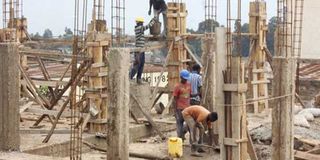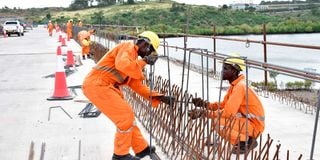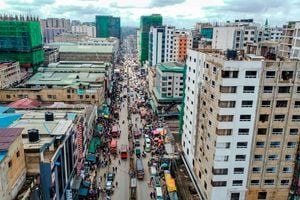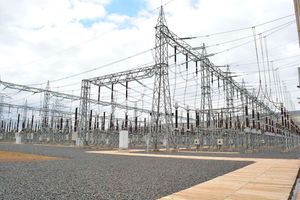
Workers at a construction site. The National Construction Authority has announced it will study the standards of the construction industry in the country. FILE PHOTO | NATION MEDIA GROUP
The construction industry contributes significantly to the country’s economy. In February this year, Nairobi County alone approved building plans worth Sh15.8 billion, an increase from Sh10.2 billion in the previous month.
In December, 2024, the county approved over Sh20 billion worth of buildings. In addition to buildings, the construction sector is involved in infrastructure development and it employs thousands of workers.
Kenya’s skyline is transforming impressively with magnificent towers rising to meet the sun. Countless buildings are clad in scaffolds as the industry comes alive with the newest designs.
But in the backdrop of this economic development, danger lurks for construction workers. A day on site might just be the last for the average construction worker in Kenya. Despite the huge contribution to economic development, the safety of workers is alarmingly neglected.
Billions of shillings goes into construction projects, yet so little is allocated to occupational safety. As the world celebrates “The World Day of Safety and Health at Work” on April 28, in this edition we explore why Kenya’s construction sector prioritises profits over human cost and what needs to be done to shift the narrative.
State of construction safety
Occupational health and safety in construction is critically under-reported. Beyond media coverage of frequent construction accidents and fatalities, there are barely any reports painting a clear picture of the situation.
The most comprehensive, publicly available report dates as far back as 2017. The report titled Common Construction Site Hazards in Nairobi County, Kenya, compiled by Raymond Kemei, analysed field data and data from the Directorate of Occupational Safety and Health. The report revealed that Kenya’s construction industry is the second most risky for workers, after the transport sector. Moreover, younger workers under 40 years were more likely to be injured or killed on construction sites as they accounted for 74% of the incidences. Falling from a height and being hit by falling objects were the most common accidents accounting for 64% of all construction site accidents.
Electrocution and accidents involving construction equipment are also fairly common. In the Kenyan context, collapsing buildings and failing scaffolds are also alarmingly common. Despite these numbers, data revealed that most construction companies allocate less than 1% of their budgets to safety.
A voice from the field
DN2 Property spoke to James Karori, a professional civil engineer who is also a certified safety consultant, and a Nema environmental lead expert. Karori is also the operations manager at Rox Engineering Ltd and a corporate member of the Institution of Engineers of Kenya (IEK) where he serves as the governance and controls committee member. Karori describes the current construction safety situation as alarming.
“There’s a noticeable gap between policy and practice. While our policies are world-class on paper, implementation is severely lacking. There’s a culture of complacency, and enforcement remains weak,” he said.

Kenya’s construction industry is the second most risky for workers, after the transport sector.
With over a decade in the industry, Karori kicked off his career as a civil engineer, but an accident motivated him to pursue safety studies and advocate for a safer construction industry. Early in his career, while working on a major infrastructure project, Karori witnessed preventable construction related accidents, and experienced the frustration of being ignored when raising safety concerns
“We were routinely transported to site in a long trailer—over 100 workers standing, no seats, or safety provisions. It felt like a disaster waiting to happen. Then one day, the worst happened—a serious accident that could have ended my life. The aftermath was filled with panic, blame games, rushed reactive measures, and a missed opportunity for proactive safety leadership. That experience opened my eyes, and I realised I needed to be part of the solution. That’s what drove me to pursue a master’s in Occupational Safety and Health and to become a certified safety consultant. Today, I use my engineering, safety, and environmental expertise to champion for safer workplaces. Sadly, attitudes haven’t shifted much,” narrates Karori.
Barriers to change, cost of safety
Lack of awareness is one of the biggest barriers to change in the industry, coupled with enforcement gaps. As Karori further explains, the industry has created a deep-rooted culture that does not promote accountability among contractors and developers. Construction speeds and cost-cutting tactics are rewarded over safety. As a result, contractors fail to provide appropriate Personal Protective Equipment (PPE), and some work with untrained or inadequately supervised workers to cut on cost.
“The lowest bidder always gets the project in construction. If contractors include safety budgets in their quotations, their bids are often overlooked,” explains Karori further noting that safety has a price tag. Ideally, occupational health and safety should account for less than 5% of an entire construction budget. The minimum requirements for safety compliance include occupational safety training for the workers, adequate Personal Protective Equipment and Safety Assessments to identify potential hazards.

Civil engineer and a certified safety consultant James Karori Nyabuto.
When it comes to training, a simple, uncomplicated and practical approach should work. The training can be tailored to suit all cadres of workers and contractors can take workers through a toolbox training every morning. Such an approach does not need to cost much.
“Most contractors think safety is expensive but compensation as per the law, is way more expensive,” Karori says.
Regulatory framework
On paper, Kenya has some of the best laws. When it comes to occupation safety, regulation falls under the Directorate of Occupational Safety & Health Services (DOSHS), under the State Department of Labour and Skills Development.
Legally, occupational safety in the construction industry is covered by the Occupational Safety and Health (OSHA) Act, 2007 and the National Building Code, 2024 which form a strong framework.
Karori notes: “These frameworks are globally competitive and comprehensive. However, enforcement remains a challenge. Without regulatory muscle and accountability on the ground, even the best laws can’t protect our workers”

Workers at a construction site.
The OSHA, is very comprehensive in outlining the general safety duties of employers (including contractors or developers) and the disciplinary actions for non-compliance. For instance, the ACT states that every employer must conduct a risk assessment and come up with mitigation measures. And if there are more than 20 workers in a construction site, the contractor or developer should formulate a health and safety committee to identify the safety hazards, conduct walkthroughs, investigate incidents and promote safety culture in that particular site. This committee has to represent all the stakeholders including the unskilled and semi-skilled workers. Construction employers are also supposed to provide appropriate PPEs for all workers. Conducting a risk assessment, helps in identifying the most appropriate PPE for a specific construction site.
Common examples of appropriate PPEs in construction include, standard helmets, if working with concrete workers need hand gloves, safety goggles and safety boots. For work involving scaling heights, they need fall arresters. Larger projects also invest in horizontal lifelines to mitigate the risk of falling. Given the noisy nature of construction sites, ear plugs are also an important requirement. When working with cement, dust masks help in preventing cement inhalation.
Scaffolding is another important area that should be looked into. In the recent past, Kenya has witnessed several fatal accidents involving collapsing scaffolds. In December 2023, for instance, at a construction project in Pangani, a scaffold collapsed from the 10th floor killing four workers and injuring a dozen others.
International standards
Karori explains that although most people use timber poles for scaffolding in Kenya, they are not the best practice.
“Every scaffold should have its maximum load capacity but with timber poles, it's hard to estimate the load capacity. However, scaffolding is very expensive and timber poles are the most available and affordable for most contractors. Scaffolds also need to be inspected every morning, but in Kenya the approach is very casual.
International construction companies take safety very seriously, when it comes to scaffolding inspection. I once worked on a project where I had to inspect the scaffolds according to international standards and issue a certificate of conformity. Such inspections require the inspector to attach their licence of practice. This increases the level of accountability in case something goes wrong,” he says.

Construction workers fix bars at the Mwache Bridge on June 24, 2022. The bridge will facilitate expansion of the Dongo Kundu special economic zone.
The biggest challenge in enforcing these laws cuts across different areas. Karori explains that training is neither site-specific nor continuous. Moreover, there is a resistance culture in the industry with most developers and contractors perceiving safety as optional, unless tragedy strikes. And even when developers go the extra mile to comply, sometimes resistance comes from the workers, especially the informal workforce. A contractor may distribute PPEs to workers, but the following day the workers go on duty without them.
Informal workers also tend to jump from one construction site to another too easily and informally, making it difficult and frustrating for contractors to invest in safety. Most people are also not aware of the laws and the consequences of non-compliance.
Digital future of construction safety
Although safety in construction sites is inarguably an added cost, Karori argues developers can start with small-scale and cost-effective strategies to increase compliance. Simple actions include, conducting simple site inductions and daily toolbox talks, carrying out basic task-specific risk assessments, and integrating safety planning from the design stage. These activities do require a lot of money.
Every site should also have a safety officer, even in a shared role. Developers must ensure workplaces are DOSHS compliant, before construction begins and include a safety budget in the Bill of Quantities. Most importantly, workers must be provided with task-appropriate PPEs and its use strictly enforced. “These practical steps, though simple, can save lives”.
The National Construction Authority also conducts free training for construction workers. Safety training can be included in these sessions and contractors can focus on working with trained workers — this will slowly increase awareness of safety issues and increase compliance in a practical and cost-effective manner. Overall, if engineers and construction professionals embrace innovation, Karori believes they can offer practical, context-based solutions.
The future of construction safety is however digital as technology is advancing. “The rollout of Digital Occupational Safety & Health Management Information System (DOSHMIS) by the Directorate of Occupational Safety and Health Services is a game-changer for regulatory compliance.
In the tech world, emerging tools include digital risk assessment templates, specialised incident and accident investigation systems, real-time communication platforms for site teams, digital safety checklists, drone surveillance for large sites, wearable gear with safety sensors, and construction equipment with hazard-detection systems. Although adoption remains slow due to cost barriers, the future of construction safety is undeniably digital”.










